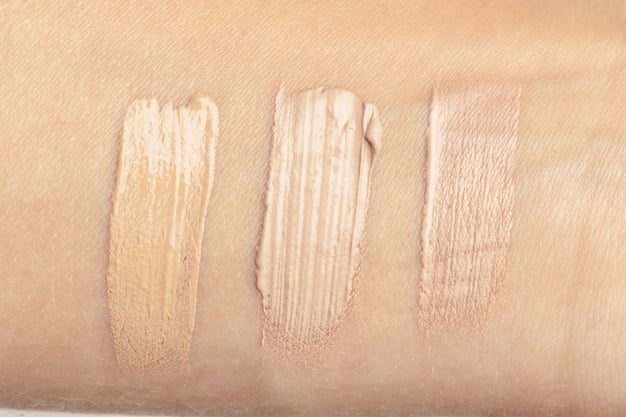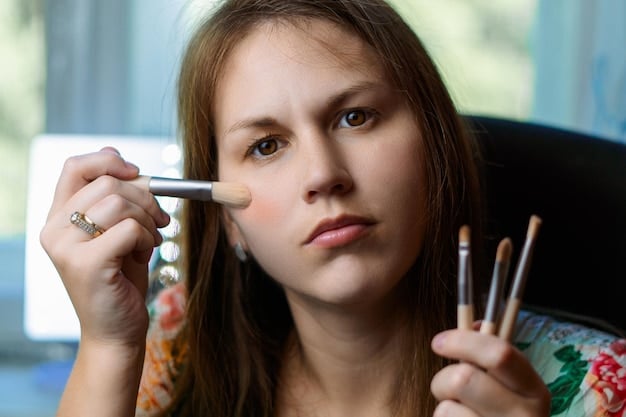The Ultimate Guide to Choosing the Right Foundation for Your Skin Type and Shade Matching

Choosing the right foundation involves understanding your skin type, selecting the correct shade, and considering the desired coverage and finish. This guide provides expert tips for achieving a flawless complexion, ensuring your foundation enhances your natural beauty.
Finding the perfect foundation can feel like searching for a needle in a haystack. But with the right knowledge, you can confidently choose a foundation that complements your skin type and enhances your natural beauty. This the ultimate guide to choosing the right foundation for your skin type (with shade matching tips) will walk you through everything you need to know.
Understanding Your Skin Type
Before diving into the world of foundations, it’s crucial to identify your skin type. Knowing whether you have oily, dry, combination, or sensitive skin will significantly impact which foundation formula works best for you. Each skin type has unique needs and benefits from different ingredients and formulations.
Oily Skin
Oily skin is characterized by excess sebum production, leading to a shiny appearance and potential breakouts. Look for oil-free, non-comedogenic, and matte-finish foundations to help control shine and prevent clogged pores.
Dry Skin
Dry skin lacks moisture and can often feel tight or flaky. Hydrating and moisturizing foundations with ingredients like hyaluronic acid and glycerin are ideal for providing much-needed hydration and a dewy finish.
- Oil-free, non-comedogenic formulas prevent clogged pores.
- Matte finishes control shine and provide a smooth base.
- Powder foundations can help absorb excess oil.

Choosing the right foundation for your skin type is the first step toward achieving flawless makeup. Understanding the specific needs of your skin will make the selection process easier and more effective.
Decoding Foundation Formulas: Liquid, Powder, Cream, and Stick
Foundations come in various formulas, each offering different levels of coverage, finish, and suitability for specific skin types. From liquids to powders, creams to sticks, understanding these distinctions is key to selecting the perfect match for your needs and preferences. Each formula has its unique application techniques and ideal skin types.
Liquid Foundations
Liquid foundations are versatile and widely popular, offering buildable coverage and a natural finish. They are suitable for most skin types, but water-based formulas are particularly beneficial for oily skin, while hydrating versions work well for dry skin.
Powder Foundations
Powder foundations are excellent for oily or combination skin, providing a matte finish and helping to absorb excess oil throughout the day. They can be applied with a brush or sponge for light to medium coverage.
- Liquid foundations offer buildable coverage and a natural finish.
- Powder foundations provide a matte finish and control shine.
- Cream foundations offer moisturizing benefits and medium to full coverage.
Selecting the right foundation formula depends on your skin type, desired coverage, and preferred finish. Experimenting with different formulas can help you discover the one that works best for you.
Mastering Shade Matching: Finding Your Perfect Hue
One of the most challenging aspects of choosing a foundation is finding the right shade. The goal is to select a shade that seamlessly blends with your skin tone, creating a natural and even complexion. Poor shade matching can result in a foundation that looks either too light, too dark, or too orange.
Understanding Undertones
Undertones are the subtle hues beneath the surface of your skin, and they play a crucial role in shade matching. The three main undertones are warm, cool, and neutral. Determining your undertone will help you narrow down your foundation choices.
Testing Shades
Always test foundation shades in natural light for the most accurate results. Apply a small amount of foundation to your jawline and blend it in. The shade that disappears into your skin is the closest match.
- Determine your undertone (warm, cool, or neutral).
- Test shades in natural light on your jawline.
- Check the shade in different lighting conditions to ensure a perfect match.

Mastering shade matching involves understanding undertones, testing shades in natural light, and considering seasonal variations in your skin tone. With practice, you can find the perfect hue that enhances your complexion.
Coverage and Finish: Achieving Your Desired Look
Foundations offer varying levels of coverage, from sheer to full, and different finishes, such as matte, dewy, or natural. Understanding the differences between these options will help you achieve your desired look. The right coverage and finish can significantly impact your overall makeup appearance.
Coverage Levels
Sheer coverage foundations provide a light, natural look, allowing your skin to show through. Medium coverage foundations even out the skin tone while still looking natural. Full coverage foundations completely conceal imperfections for a flawless finish.
Foundation Finishes
Matte finishes are shine-free and ideal for oily skin. Dewy finishes provide a radiant, luminous look, perfect for dry skin. Natural finishes offer a balanced, skin-like appearance suitable for all skin types.
- Choose sheer coverage for a natural, everyday look.
- Opt for medium coverage to even out skin tone.
- Select full coverage to conceal imperfections.
The perfect foundation will not only match your skin tone but also provide the coverage and finish that align with your personal preferences and desired makeup look.
Application Techniques: Achieving Flawless Results
Achieving a flawless foundation application requires the right tools and techniques. Whether you prefer using a brush, sponge, or your fingers, proper application can make a significant difference in the final look. Preparation and technique are key to a smooth, even finish.
Choosing the Right Tools
Foundation brushes, such as flat foundation brushes, stippling brushes, and buffing brushes, can provide a smooth, even application. Sponges, like makeup sponges and beauty blenders, offer a natural, airbrushed finish. Fingers can be used for light coverage and a natural look.
Application Steps
Start with a clean, moisturized face. Apply a primer to create a smooth base. Apply the foundation in thin layers, starting from the center of your face and blending outward. Set the foundation with a setting powder for long-lasting wear.
- Use a foundation brush for even application and coverage.
- Opt for a makeup sponge for a natural, airbrushed finish.
- Apply foundation in thin layers, blending outward from the center of your face.
Mastering foundation application techniques involves choosing the right tools, preparing your skin, and applying the foundation in thin, even layers. With practice, you can achieve a flawless complexion every time.
Long-Lasting Wear: Tips and Tricks for Staying Power
Ensuring your foundation lasts all day involves more than just picking the right product. Proper skincare, priming, setting, and touch-ups are essential for achieving long-lasting wear. With the right techniques, you can keep your foundation looking fresh and flawless from morning to night.
Skincare and Priming
Start with a clean, moisturized face to create a smooth canvas for your foundation. Apply a primer to help the foundation adhere to your skin and prevent it from sliding off.
Setting and Touch-Ups
Set your foundation with a translucent setting powder to lock it in place and control shine. Carry blotting papers and a compact powder for touch-ups throughout the day.
- Start with a clean, moisturized face.
- Apply a primer to create a smooth base.
- Set your foundation with a translucent setting powder.
Achieving long-lasting foundation wear involves proper skincare, priming, setting, and touch-ups. By following these tips, you can keep your makeup looking fresh and flawless all day long.
| Key Point | Brief Description |
|---|---|
| ✨ Skin Type | Identify if you have oily, dry, combination, or sensitive skin. |
| 🎨 Shade Matching | Test shades in natural light on your jawline. |
| ✔️ Coverage | Choose sheer, medium, or full coverage based on your preference. |
| 🖌️ Application | Apply in thin layers, blending outward from the center of your face. |
Frequently Asked Questions (FAQs)
▼
Check the color of your veins on your wrist. Blue or purple veins indicate cool undertones, green veins indicate warm undertones, and blue-green veins suggest neutral undertones.
▼
Look for hypoallergenic, fragrance-free, and non-comedogenic foundations. Mineral foundations are often a good choice as they typically contain fewer irritants.
▼
Liquid foundations generally last about 12-18 months, while powder foundations can last up to 2 years. Always check for changes in texture, smell, or color.
▼
Yes, mixing foundations can help you achieve a perfect shade match or customize the coverage and finish. Ensure the formulas are compatible to avoid separation.
▼
Using a primer is highly recommended as it creates a smooth base, helps the foundation adhere better, and prolongs its wear. It can also address specific skin concerns like oiliness or dryness.
Conclusion
Choosing the right foundation involves a combination of understanding your skin type, mastering shade matching, and selecting the right coverage and finish. By following the tips and techniques outlined in this guide, you can confidently find the perfect foundation that enhances your natural beauty and provides a flawless complexion.





